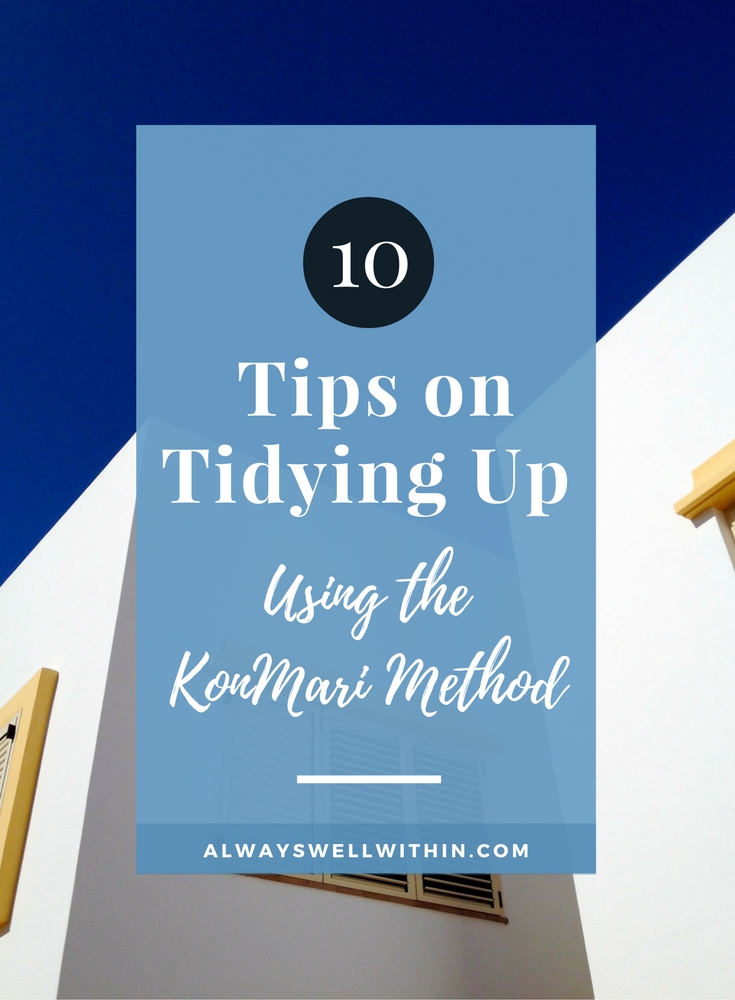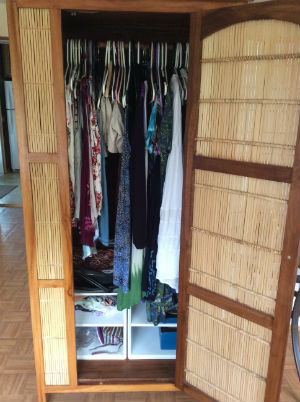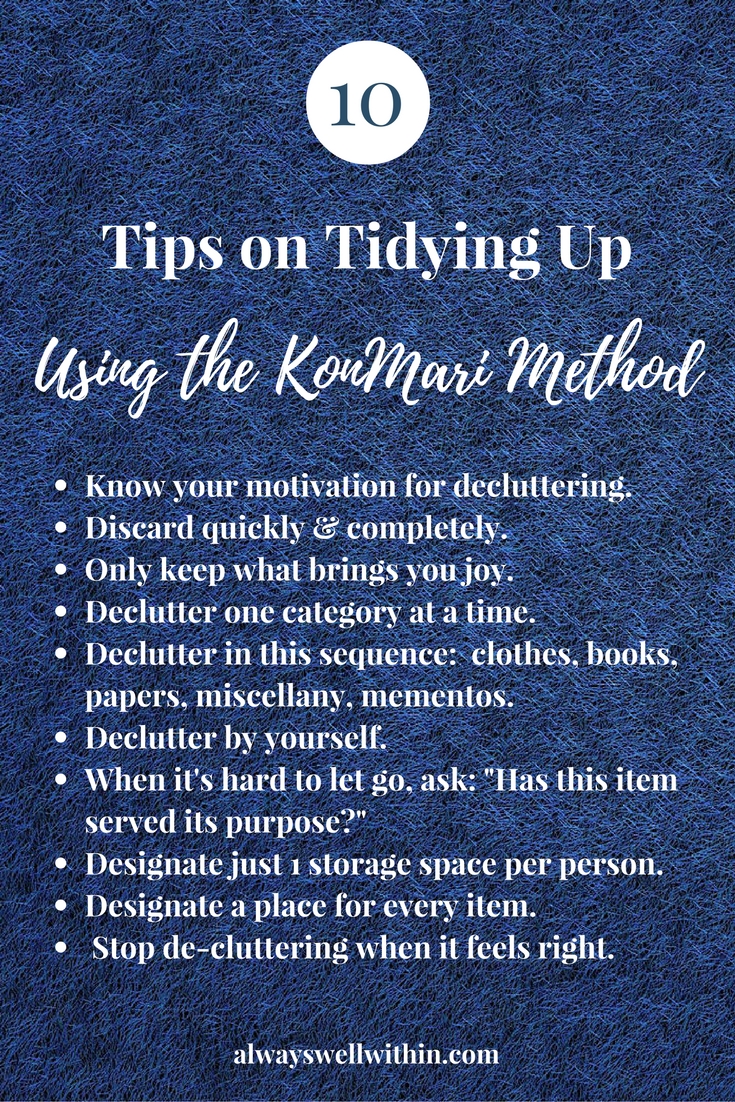The Best Way to Declutter So You Feel Happy at Home {KonMari Style}
 I know, without a doubt, that my energy feels uplifted after tidying up or de-cluttering. I believe that clutter and chaos depresses the spirit in an invisible way that you may never notice until after a good cleaning and clearing session like I do.
I know, without a doubt, that my energy feels uplifted after tidying up or de-cluttering. I believe that clutter and chaos depresses the spirit in an invisible way that you may never notice until after a good cleaning and clearing session like I do.
I didn’t develop a healthy habit of tidying up as a child or as a teen, as my mother did all the housework. I tended to disorderliness, a sign I think of not having or wanting to have my feet firmly planted on this earth.
As long as it’s not noisy, I can work in a physically chaotic environment due to my enhanced ability to focus. But it doesn’t feel optimal. Also, I notice an immediate feeling of aversion whenever I encounter a messy house or space. I see this as a sign that disorder is not conducive for my own well-being. I suspect this is true across the board for almost all of us. How is it for you?
During my one-week spring break, I went into active cleaning, decluttering, and organizing mode. It felt so good to clean out under the sinks, reorganize my closet, and reduce my archive file box to a few inches of folders from its previous bursting at the seems appearance. During this time, I decided to read The Life-Changing Magic of Tidying Up, the Japanese Art of Decluttering and Organizing by Marie Kondo to keep the positive momentum going.
To be honest, I find most books on decluttering boring. But this book is unique, perhaps due to its roots in Japanese culture. It’s been wildly popular, selling more than 2 million copies. Kondo's book confirmed my intuitive claims by asserting that putting your house in order can positively effect all other areas of your life. She even suggests that your life will change dramatically when you finish the process.
There are two phases to the tidying up process using the KonMari method:
- Discarding
- Finding a place for everything that remains
Here are ten of the most important tips from The Life-Changing Magic of Tidying Up and my commentary on what I found useful or not.
1. What’s Your Motivation for Decluttering and Ideal Style?
Kondo encourages you to ask these questions as a prelude to the hands on work of the KonMari method.
- What’s your motivation for tidying up?
- What do you wish to gain from tidying up?
- What does your ideal lifestyle look light?
She nudges you to think these questions through deeply and to vividly visualize the outcome you desire from your decluttering process as concretely as possible. This will reduce your risk of “rebound” into messy habits and a messy house once again.
I think this step is one of the most important elements of Kondo's book. A clear motivation for decluttering serves like a touchstone you can return to whenever you feel discouraged, tempted to lapse, or lured into procrastination. It will help you stay on track with the KonMari method and accomplish your vision for a clutter-free home.
These are my motivations.
- I want to save time for what’s truly important to me. Disorganization always results in lost time and frustration when you can’t find what you need.
- I want to live in a more uplifted energetic space.
- I seek simplicity of mind and find that physical simplicity supports this.
- Living simply is my small contribution to a more sustainable earth.
As to style, I call my desired look “zen elegance.”
2. Start by Discarding, Quickly and Completely
That sounds intimidating, but Kondo actually means up to six months when she uses the word “quickly.” The aim is to rapidly begin to feel the positives of living with less clutter so you’re inspired to continue and never go back.
If you interrupt discarding with organizing, you may never finish this vital part of the process. The remaining excess will make you more prone to clutter. The secret of Kondo's successful method, she says is to follow the right order and discard first, quickly and completely.
3. Keep What Brings You Joy, Discard the Rest

Kondo says to focus more on what you want to keep rather than on what you want to discard by using joy as the selection criteria. You must physically touch each item and ask, “Does this spark joy?” This might sound wonky, but try it out and see what happens. Your heart knows whether you truly love an item far better than your brain.
The goal is to whittle away everything that doesn’t bring you joy so in the end you’re surround only by the items that uplift your heart. By doing this, Kondo says you can reset your life and begin a new, more satisfying lifestyle.
4. Declutter One Category at a Time
Most people declutter by location. When you use the KonMari method, you proceed instead by bringing together all the items you own in one category - all your clothes or all your pens, for example. It will be easier to make an accurate assessment of what you want to keep and discard if all the items are brought together. Then you can see them as a whole and compare them as needed. This also avoids the wasted time of starting over again and again with similar types of items.
Then, you physically touch or hold each item and ask, “Does this spark joy?”
This clustering approach has worked well for me with some categories like all my clothes or all my books. But, for me, it’s sometimes easier to de-clutter by location. For example, clearing out one desk drawer feels manageable for me when I have a small window of time. I think it’s worthwhile to try both approaches and see which one works best for you.
5. Declutter In This Sequence
Kondo recommends starting with the easiest categories first, the ones that usually have the least sentimental value. Therefore, it’s easier to discard items in the beginning, and you'll move through your decluttering process faster. This is the sequence she recommends:
- Clothes
- Books
- Papers
- Miscellany
- Mementos
For clothes, she recommends breaking them down further into these categories:
- Tops
- Bottoms
- Jackets, Coats, Suits
- Socks
- Underwear
- Bags
- Accessories
- Situation specific clothing (swimsuits, uniforms, and the like)
- Shoes
Your decluttering will go more smoothly when you follow this order, claims Kondo based on her years of experience helping people simplify and organize their homes.
6. Declutter On Your Own
There’s nothing more frustrating than truly wanting to discard an item and having your action blocked by someone else. That can happen if your partner, friend, or someone in your family tends to be a packrat. Or they may just feel a strong attachment to particular items you own.
Central to Kondo’s approach is your internal dialog concerning what brings YOU joy. Hearing your heart whispers can best be done alone and in a relatively quiet environment. Bringing other people into the picture can muddy this up.
At the same time, decluttering as a couple or a family can be a healthy way to support a happier and more sustainable lifestyle together. If everyone is committed, a group effort could definitely be the way to go, although each person will ideally focus on their own items first before collective items are addressed together.
7. When It’s Hard to Let Go
You will instinctively know what is best to keep and what is better gone. Just hold the item and ask the key question, “Does this spark joy.” The problem comes when the rational mind pipes in to say, “Maybe, I’ll need this later.” Or, “How can I give this away, it cost so much?” As best as you can, Kondo suggests, go with your heart, not your head.
One key question to ask when you find it hard to separate from an item is, “Has this item fulfilled its purpose?” For example, that ill-fitting dress might have cost a ton, but it has shown you the specific features that don’t complement your body well. It will be easier to let it go when you realize an item has fulfilled its purpose and thus is no longer needed in your life.
8. Storage
Once you are surrounded by only the items you love, you’ll have far less and thus require less storage space too. Kondo offers many small tips on how to store your stuff in an efficient way - far too many to share here.
Kondo's overarching theme for storage is simplicity. She recommends:
- Keep all items of the same type in one place.
- Not to scatter your storage all about.
Kondo highly recommends one storage place per person, ideally using your closet as your main storage unit. If you have too many storage areas, it's easy for clutter to descend once again. She says never store items on the floor of your home (clutter, right?), and is adamant that you don’t need expensive storage solutions.
9. Designate a Place for Every Item
An item without a place increases the chance your house will get messy again. This is one of the main reasons for rebound.
First, designate a place for every single item. For example, I now keep my keys in a zippered pocket in purse. Instead of laying them on a table or the kitchen counter, I always return them to this pocket. I no longer lose time searching for my keys!
Then, when you finish using an item, put it in its designated spot. This, I find is the biggest challenge when it comes to sustaining a decluttered space. There's always the temptation to procrastinate, put the item down where you happen to be, and say you'll put it away later.
Kondo says that once you have your storage set up, in the same place or close proximity, it becomes natural to put things away.
10. Stop Decluttering When It Feels Right
At some point in your process of reduction, you’ll come to a point when it feels like you have just the right amount of things to live comfortably. You'll feel a "click" and that's when it's time to stop and enjoy your more spacious home.
When you follow her process and get to this perfect point, Kondo claims you’ll never rebound. That’s where I would like to be! However, since Kondo’s motto when it comes to paper is not to keep any at all, I fear I might get stuck at that point. Time will tell.

I didn’t finish my deep cleaning and decluttering process in that one spring week, but I took some big steps forward. I plan to finish tidying up over the summer using the KonMari suggestions that resonate for me. Wish me good luck!
How do you declutter and tidy up? Have you tried the KonMari method? How did it work for you?
Thank you for your presence. If you enjoyed this article, please share it with your friends. Thank you! May you be well, happy, and safe - always. With love, Sandra